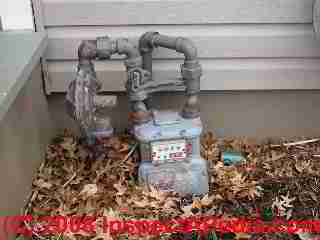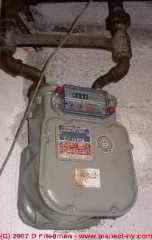 Gas Meters Inspection Tips
Gas Meters Inspection Tips
for Home Inspectors & Owners
- POST a QUESTION or COMMENT about residential gas meters, inspection, diagnosis, repair
Gas meters in homes: inspection, troubleshooting, leaks, reporting.
This article explains how to visually inspect natural or piped-in gas meters for defects and safety concerns. This document provides free sample draft home inspection report language for reporting defects in oil and gas piping at residential properties.
Here we provide descriptions and photographs of unsafe gas piping, indications of unsafe or improperly operating gas appliances, gas meters, and other gas installation defects are provided.
InspectAPedia tolerates no conflicts of interest. We have no relationship with advertisers, products, or services discussed at this website.
- Daniel Friedman, Publisher/Editor/Author - See WHO ARE WE?
Safety & Inspection of Natural Gas Meters for Home Inspectors & Home Owners
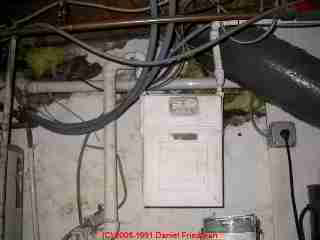 Immediate LP or natural gas safety hazards: if there is evidence of an LP or natural gas leak at a building, gas odors, for example, you should:
Immediate LP or natural gas safety hazards: if there is evidence of an LP or natural gas leak at a building, gas odors, for example, you should:
- Do not do anything that is likely to cause a gas explosion, such as lighting a match, operating an electrical switch, or even using a telephone in the building
- Leave the building immediately
- Notify other building occupants of the safety concern
- Contact the local gas company and/or fire department
Indoor Gas Meter Inspection, Defects, & Recommendations
Gas meter location: gas meters are located outdoors except when special permission is given by the gas company.
Indoor gas meters increase the risk of an indoor gas leak, require special venting, and can make it more dangerous to shut off gas in an emergency.
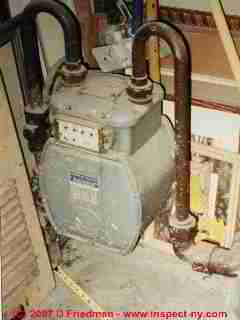 If your gas meter is located indoors you should discuss this matter with your gas company.
If your gas meter is located indoors you should discuss this matter with your gas company.
In this photo the gas meter shown is an obsolete model (so perhaps at higher risk of dangerous natural gas leaks into the building (an explosion hazard), and we saw no gas regulator and no vent from the meter to outside.
This meter needs to be inspected by the local gas company. It may need to be relocated outside or vented to outside for safety.
Natural gas or piped-in gas safety warning: improper installation and even improper inspection and testing methods involving natural or "LP" gas can involve dangerous conditions and risk fire or explosion.
If you smell gas you should leave the building immediately and should do so without doing anything that could create a spark such as operating a light switch or telephone. From a safe location, call your gas company's emergency line and/or your fire department.
If the gas meter is located close to a heating system, such as in this photograph where the piped-in natural gas meter and its control valve were
located next to and nearly touching a hot air furnace, you should review the safety and building code compliance installation with your gas company.
Gas
piping or meters which could leak gas into a heating system or duct system are dangerous.
If the gas meter is close to or touching the ground outdoors or touching a building surface indoors, such as in the photographs above where the piped-in natural gas meter is outside partly buried and inside the gas meter resting on and touching brick in a wet basement, there is a danger of gas meter corrosion and dangerous gas leaks.
Outside the soil needs to be removed so that the meter is not touching dirt. If this corrective measure means that we've created a low area by the foundation it's important to keep roof spillage out of the low spot or we may invite building foundation leaks and basement water entry.
A window well can be installed around such an excavation to help keep surface runoff away from the building.
Details are at GAS METER CODES & CLEARANCE DISTANCES
You should review the safety and building code compliance installation with your gas company as soon as possible.
Gas piping or meters which could leak gas are dangerous. In this photograph (click the photograph to enlarge it) corrosion is visible on the bottom of the gas meter where it's supported by wet brick.
Gas Meter Capacity or Adequacy
Safety Suggestion: gas meter adequacy: If additional gas equipment has been added to this building since the installation of the original gas service meter, it is possible that the added demand can result in low gas pressure or unsafe operation.
The meter itself may need to be replaced with a higher capacity unit for safety. Please review this question with your gas supplier.
Gas Meter Venting Requirements
When a gas meter is used indoors good practice and plumbing codes require that the meter regulator be connected to a vent pipe extending to the outdoors so that in the unlikely event of a leak-failure of the gas pressure regulator, leaking gas will not accumulate in the building where it would form an explosion hazard.
Safety Recommendation: gas regulator vent: We did not find a vent pipe venting the gas regulator (located inside the building) to outside.
Such vents are recommended and may be required by local or state codes for safety.
Please review this question with your gas supplier.
Also see the US DOE publication
HOW to READ RESIDENTIAL ELECTRIC & NATURAL GAS METERS [PDF]
...
Reader Comments, Questions & Answers About The Article Above
Below you will find questions and answers previously posted on this page at its page bottom reader comment box.
Reader Q&A - also see RECOMMENDED ARTICLES & FAQs
On 2020-11-30 by Gamble/Eury Historic House Museum - need parts for this 1960s American Gas Meter Company 5B-225
We are still needing parts/whole meter for our 1960 American Gas Meter Company 5B-225. If you know where to find any parts for this meter and/or for The Cincinnati Gas and Electric Company (CG&E) around this era, please contact us @ 937-783-2729 (landline).. I have attached a picture of our restored meter in its "close to' original color of atomic turquoise. Thank you...
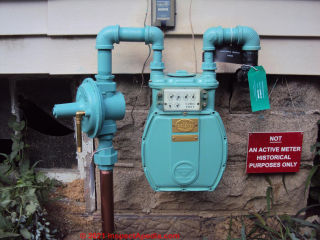
On 2020-11-30 by Gamble/Eury Historic House Museum - The Cincinnati Gas and Electric Company (CG&E) meter parts needed
&E) around this era, please contact us @ 937-783-2729 (landline).. I have attached a picture of our restored meter in its "close to' original color of atomic turquoise. Thank you...
Anybody know where to find any 1960 American Gas Meter Company 5B-225 Cu Ft Per Hr gas meter parts?
The third picture down used on this website (green gas meter with black pipes) is a 1965ish American Meter Co 225 Cu Ft Per Hr. We are restoring our gas meter and need parts and/or whole meter
. I have attached an image of our meter.. Please give us a call at 937-783-2729.. Thank you :)
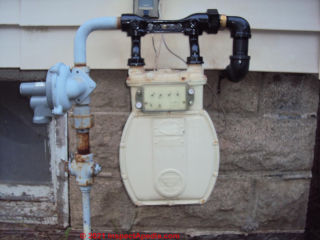
On 2020-02-03 - by (mod) -
Viv
I've certainly come across multiple-occupant buildings where the landlord didn't get separate meters for gas or water or electricity, and one poor tenant ends up paying for the utilities consumed by her neighbours.
Ask the gas company to come to the site - or a licensed plumber - to follow the gas piping to see who's getting fueled by which meter.
On 2020-02-03 by vivienne oneill
can the gas meter in your home be linked to another home/business? gas company just changed my meter and told me the meter they have on file is not the one they removed..
On 2020-01-26 - by (mod) -
In my opinion it's dangerous for a gas meter to be buried at all. The concern is that the meter base is exposed to additional corrosive forces and therefore could leak. The hazards of a gas leak are obvious, explosion and Fire.
On 2020-01-26 by Fran
My gas meter is half buried in dirt is this dangerous
...
Continue reading at GAS METER CODES & CLEARANCE DISTANCES or select a topic from the closely-related articles below,Replace with (MAYBE - CHECK EACH ONE) or select a topic from the closely-related articles below, or see the complete ARTICLE INDEX.
Or see GAS METER FAQs - questions & answers posted originally at the end of this page.
Or see these
Recommended Articles
- GAS BTUH, CUBIC FEET & ENERGY - how to calculate or convert between cubic feet of gas, liquid gallons of LP gas, and BTUs per cubic foot or gallon of gas fuels.
- GAS LEAK DETECTION, LP / NG
- GAS LP & NATURAL GAS SAFETY HAZARDS
- GAS METERS - home
- GAS PIPING, VALVES, CONTROLS - home
- GAS PIPING CLEARANCES, CODES & DEFECTS
- GAS PRESSURES LP vs NATURAL GAS
- GAS REGULATORS & APPLIANCE / HEATER CONTROLS - home, Natural Gas regulators & appliance regulators, NG & LP
- GAS REGULATORS for LP TANKS - home, LPG / Propane systems
- GAS TANKS LP / PROPANE
Suggested citation for this web page
GAS METERS at InspectApedia.com - online encyclopedia of building & environmental inspection, testing, diagnosis, repair, & problem prevention advice.
Or see this
INDEX to RELATED ARTICLES: ARTICLE INDEX to GAS APPLIANCES, PIPING, CONTROLS
Or use the SEARCH BOX found below to Ask a Question or Search InspectApedia
Ask a Question or Search InspectApedia
Questions & answers or comments about residential gas meters, inspection, diagnosis, repair.
Try the search box just below, or if you prefer, post a question or comment in the Comments box below and we will respond promptly.
Search the InspectApedia website
Note: appearance of your Comment below may be delayed: if your comment contains an image, photograph, web link, or text that looks to the software as if it might be a web link, your posting will appear after it has been approved by a moderator. Apologies for the delay.
Only one image can be added per comment but you can post as many comments, and therefore images, as you like.
You will not receive a notification when a response to your question has been posted.
Please bookmark this page to make it easy for you to check back for our response.
IF above you see "Comment Form is loading comments..." then COMMENT BOX - countable.ca / bawkbox.com IS NOT WORKING.
In any case you are welcome to send an email directly to us at InspectApedia.com at editor@inspectApedia.com
We'll reply to you directly. Please help us help you by noting, in your email, the URL of the InspectApedia page where you wanted to comment.
Citations & References
In addition to any citations in the article above, a full list is available on request.
- U.S. Energy Information Administration - eia.doe.gov/
- U.S. Environmental Protection Agency - epa.gov/solar/energy-and-you/affect/natural-gas.html
- At Natural Gas.Org www.naturalgas.org/environment/naturalgas.asp#emission you’ll find a table of combustion products
- At geocities.com/rainforest/6847/report1.html is an interesting and detailed though not “neutral” report on the components and contaminants in the combustion of natural gas. You’ll see a long long list of emissions products, but look again – most of the contaminant levels listed are in the picograms.
- apvgn.pt/documentacao/iangv_rep_part1.pdf lists the components in natural gas exhaust from vehicles
- The Need Project, Manassas, VA: need.org/needpdf/infobook_activities/SecInfo/NGasS.pdf
- Kroschwitz, Jacqueline I., and Mary Howe-Grant (eds.). "Gas, Natural." In Encyclopedia of Chemical Technology. 4th ed., vol. 12. New York: John Wiley and Sons, Inc., 1993.
- Tussing, Arlon R., & Bob Tippee. The Natural Gas Industry: Evolution, Structure, and Economics. 2nd ed. Tulsa, OK: PennWell Publishing, 1995.
- Our recommended books about building & mechanical systems design, inspection, problem diagnosis, and repair, and about indoor environment and IAQ testing, diagnosis, and cleanup are at the InspectAPedia Bookstore. Also see our Book Reviews - InspectAPedia.
- In addition to citations & references found in this article, see the research citations given at the end of the related articles found at our suggested
CONTINUE READING or RECOMMENDED ARTICLES.
- Carson, Dunlop & Associates Ltd., 120 Carlton Street Suite 407, Toronto ON M5A 4K2. Tel: (416) 964-9415 1-800-268-7070 Email: info@carsondunlop.com. Alan Carson is a past president of ASHI, the American Society of Home Inspectors.
Thanks to Alan Carson and Bob Dunlop, for permission for InspectAPedia to use text excerpts from The HOME REFERENCE BOOK - the Encyclopedia of Homes and to use illustrations from The ILLUSTRATED HOME .
Carson Dunlop Associates provides extensive home inspection education and report writing material. In gratitude we provide links to tsome Carson Dunlop Associates products and services.


